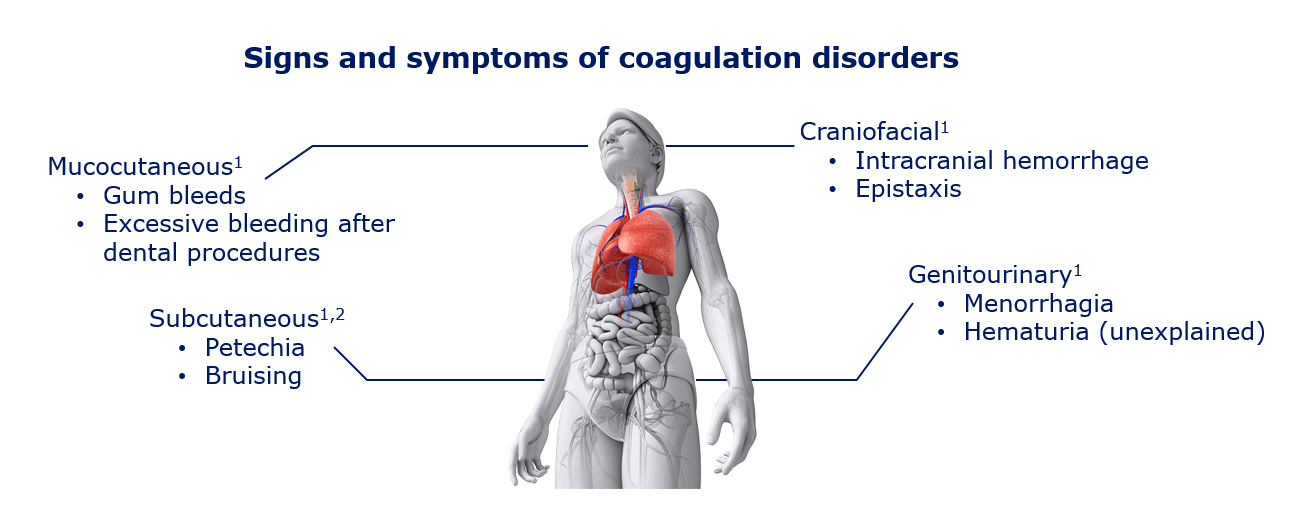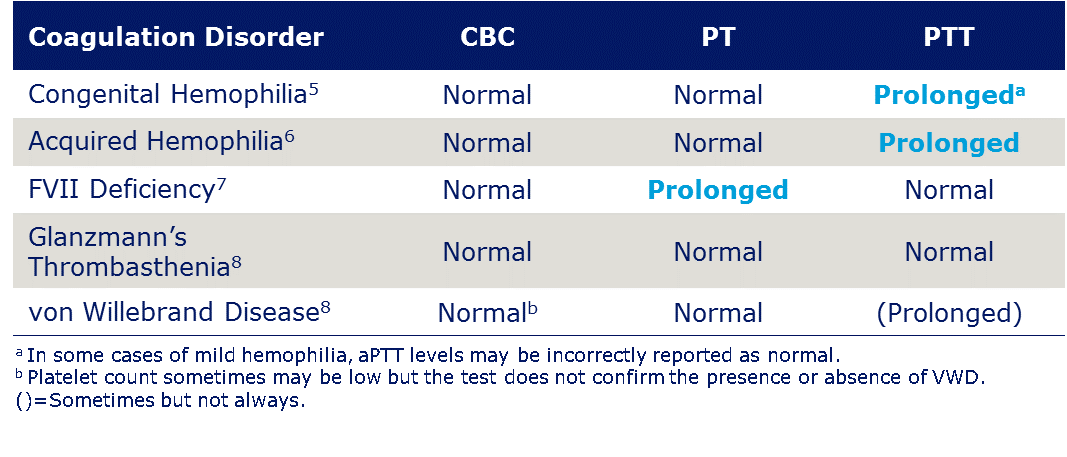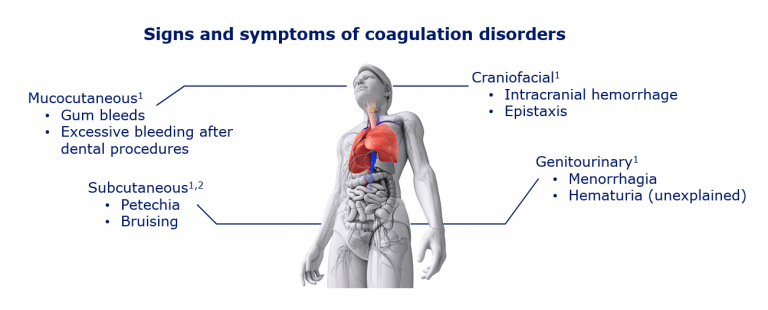
Bleeding disorders encompass many conditions that are a result of some type of blood clotting issue.3 There are 2 types of bleeding disorders, inherited and acquired. Most people are familiar with the bleeding disorder congenital hemophilia, but the most common inherited bleeding disorder is von Willebrand disease (VWD).3 Acquired bleeding disorders are more rare than congenital bleeding disorders like VWD and hemophilia, and they can develop at any age. For example, in acquired hemophilia, the body develops antibodies that attack the blood’s natural clotting factor VIII.4
If a patient presents with abnormal bleeding in the ED with no clear cause, then it’s important for ED physicians to consider a bleeding disorder. Indications for a bleeding disorder may not always be evident in the results of a CBC; however, other coagulation tests, including a PT and a PTT, can be ordered to indicate the presence of some bleeding disorders.5-8 Another way for ED physicians to identify a possible bleeding disorder is to assess the patient’s medical history. Women with VWD, factor VII deficiency, or Glanzmann’s thrombasthenia may present in the ED with heavy menstrual bleeding, but they often have had abnormal bleeding symptoms in the past.9-13 For example, they may have had prior excessive gum bleeding when brushing their teeth or excessive bleeding after minor injuries. ED physicians should also assess the patient’s family medical history. Having family members with a history of excessive bleeding may indicate that an inherited bleeding disorder is present.9-13

If ED physicians have considered all other possible explanations for excessive bleeding (eg, other medications), they may want to consider a bleeding disorder diagnosis and consult a hematologist. Often, hematologists will recommend or be able to perform specific coagulation tests that are not part of the routine tests done in the ED. Although bleeding disorders are rare, ED physicians should be aware of them and consider them in cases of unexplained bleeding in the ED.
To learn more about recognizing bleeding disorders in the ED, listen to the Urgent Matters podcast with Dr Charlie Pollack, Associate Provost for Innovation in Education at Thomas Jefferson University and Professor and Senior Advisor for Interdisciplinary Research and Clinical Trials, Department of Emergency Medicine, Sidney Kimmel Medical College of Thomas Jefferson University.
To hear a hematologist’s perspective on unexplained bleeding, listen to the Urgent Matters podcast with Dr Joanna Davis, Associate Professor of Clinical Pediatrics at the University of Miami Leonard Miller School of Medicine and Medical Director of Comprehensive Pediatric Hemophilia Treatment at the University of Miami.
You can also learn more by watching the True Stories of Bleeding Disorders in the Emergency Department webinar by Urgent Matters.
This blog is sponsored by Novo Nordisk and the physicians are compensated by Novo Nordisk.
References:
- Karnath BM. Hosp Physician. 2005;35-39.
- Anderst JD et al. Pediatrics. 2013;131(4):e1314-e1322.
- Bleeding disorders. American Society of Hematology website. http://www.hematology.org/Patients/Bleeding.aspx. Accessed July 13, 2018.
- Huth-Kühne A et al. Haematologica. 2009;94(4):566-575.
- Srivastava A et al. Haemophilia. 2013;19(1):e1-e47.
- Collins P et al. BMC Res Notes. 2010;3:161.
- Mumford AD et al. Br J Haematol. 2014;167(3):304-326.
- Kessler CM. In: Kitchens CS, et al. Consultative Hemostasis and Thrombosis. 3rd ed. Philadelphia, PA: Saunders Elsevier; 2013:16-32.
- US Department of Health and Human Services. National Institutes of Health. The Diagnosis, Evaluation, and Management of von Willebrand Disease. https://www.nhlbi.nih.gov/files/docs/guidelines/vwd.pdf. NIH Publication No. 08-5832. Published December 2007. Accessed July 12, 2018.World Federation of Hemophilia. What Are Rare Clotting Factor Deficiencies? Montréal, Québec, Canada: World Federation of Hemophilia; 2009.
- Lapecorella M et al. 2008;14(6):1170-1175.
- George JN et al. 1990;75(7):1383-1395.
- Sharathkumar AA, Shapiro A. Platelet Function Disorders. 2nd ed. Montréal, Québec, Canada: World Federation of Hemophilia; 2008.
Novo Nordisk is a registered trademark of Novo Nordisk A/S.
© 2018 Novo Nordisk All rights reserved. US18HRBD00094 August 2018


